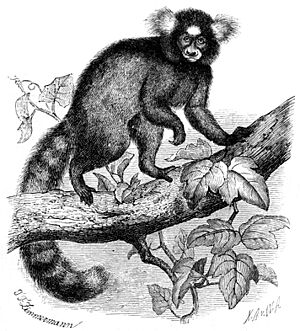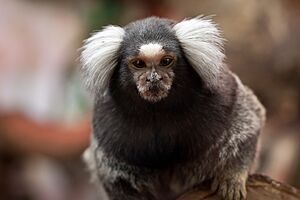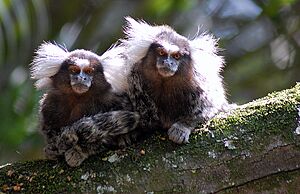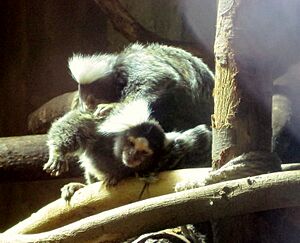Common marmoset facts for kids
The common marmoset (Callithrix jacchus) is a small monkey from the New World. It first lived on the northeastern coast of Brazil. You could find them in states like Piaui, Paraiba, Ceará, Rio Grande do Norte, Pernambuco, Alagoas, and Bahia.
Since the 1920s, these marmosets have spread to southeastern Brazil. This happened because some were released from captivity, both on purpose and by accident. In places like Rio de Janeiro, where they were first seen in the wild in 1929, they have become an invasive species. This means they can cause problems for other animals. For example, they might mix with similar monkeys like the buffy-tufted marmoset (Callithrix aurita). They also sometimes eat bird eggs and baby birds.
In 2014, scientists mapped out the entire genetic code (called the whole-genome sequence) of a female common marmoset. It was the first New World Monkey to have its full genome sequenced!
Quick facts for kids Common marmoset |
|
|---|---|
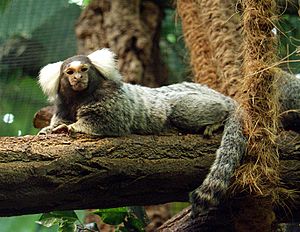 |
|
| Conservation status | |
| Scientific classification | |
| Kingdom: | |
| Phylum: | |
| Class: | |
| Order: | |
| Family: |
Callitrichidae
|
| Genus: |
Callithrix
|
| Species: |
C. jacchus
|
| Binomial name | |
| Callithrix jacchus (Linnaeus, 1758)
|
|
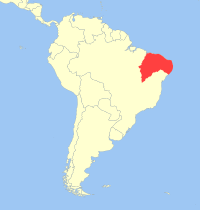 |
|
| Geographic range | |
| Synonyms | |
|
|
Contents
What Do Common Marmosets Look Like?
Common marmosets are very small monkeys. They have tails that are quite long compared to their bodies. Male and female marmosets are about the same size. Males are just a little bit bigger.
On average, males are about 188 mm (7.4 in) tall. Females are usually around 185 mm (7.3 in) tall. Males weigh about 256 g (9.03 oz), and females weigh about 236 g (8.32 oz).
Their fur is many colors, with sprinkles of brown, gray, and yellow. They have white tufts of fur around their ears. Their tails have bands of color. Their faces have pale skin, and they have a white stripe on their forehead. Baby marmosets have brown and yellow fur. Their ear tufts grow in later.
Special Features of Marmosets
Like other monkeys in their group (genus Callithrix), common marmosets have claw-like nails. These are called tegulaes. Most of their fingers have these claws. Only their big toes (halluxes) have flat nails, like most other primates.
Marmosets move through trees like squirrels do. They can hang onto trees straight up and jump between them. They also run on all fours across branches. Their claw-like nails help them move this way. Other special features include large, chisel-shaped front teeth. They also have a special part of their gut called a cecum. These features help them eat their unique diet.
Where Do Common Marmosets Live?
Common marmosets are originally from east-central Brazil. They have also been brought to other places. Now, they live in cities like Rio de Janeiro in Brazil and Buenos Aires in Argentina.
You can find marmosets in many types of forests. They live in Atlantic coastal forests and also in semi-deciduous forests further inland. They can also live in savanna forests and forests along rivers. Marmosets do well in dry, regrowing forests and at the edges of forests.
What Do Common Marmosets Eat?
The common marmoset's claw-like nails, tooth shape, and gut are perfect for their special diet. They mostly eat plant exudates and insects. Exudates are sticky liquids like gum, sap, latex, and resin that come from trees.
Marmosets use their claws to hold onto the side of a tree. Then, they use their long lower front teeth to chew a hole in the tree. After that, the marmoset licks up the sticky liquid or scoops it out with its teeth. Eating these exudates makes up 20-70% of their feeding time.
Exudates are a steady food source for marmosets, especially from January to April. This is when fruits are not easy to find. A marmoset might visit the same tree hole many times. They even use holes made by other animals.
Insects are also a very important food for marmosets. They spend 24-30% of their feeding time eating insects. Because marmosets are small, they can live on insects. They are also good at sneaking up on and catching insects. Marmosets also eat fruits, seeds, flowers, fungi, nectar, snails, lizards, tree frogs, bird eggs, baby birds, and even baby mammals. They might compete for fruit with birds like parrots and toucans, and with woolly opossums.
Common Marmoset Behavior
How Marmosets Live Together
Common marmosets live in stable extended families. Only a few members in the group are allowed to have babies. A marmoset group can have up to 15 members, but usually, there are about nine. A family group typically has one or two breeding females, one breeding male, their babies, and their adult relatives. These relatives could be their parents or siblings.
The females in a group are usually closely related. The males are less so. Males do not mate with breeding females they are related to. Marmosets might leave their family groups when they become adults. This is different from other primates who leave when they are teenagers. We don't know much about why marmosets leave their groups.
Family groups will split into new groups if a breeding male dies. Within the family, the marmosets that are breeding are usually more in charge. The breeding male and female often share power. However, between two breeding females, one is usually more dominant. The female who is less dominant is usually the daughter of the dominant one. For other group members, their social rank depends on their age. Dominance is shown through different actions, body positions, and sounds. Less dominant marmosets will groom (clean the fur of) those higher up in rank.
Reproduction and Life Cycle
The breeding marmosets in a group need other members to help raise their young. The breeding pair will use their behavior and bodies to stop other group members from having babies. Since these stopped individuals are likely related to the breeding pair, they have a reason to care for the young because they share genes with them. Also, if a related male is present, it can affect when a female can get pregnant. Studies have shown that females don't get pregnant when their fathers are around. But they can get pregnant when an unrelated male is there.
When conditions are right for them to breed, adult females have babies regularly for the rest of their lives. Pregnancy lasts for five months. Females are ready to have babies again about ten days after giving birth. They give birth twice a year, with about five months between each birth.
Marmosets often give birth to two non-identical twins. Because of this, females are under stress during pregnancy and when they are feeding their babies. They need help from the other family members. Baby marmosets naturally cling to their mother's back. They don't let go on their own for the first two weeks. After that, they become very active and start exploring their surroundings.
The breeding male (who is likely the father) will start carrying the twins. All members of the family will help care for them. In the weeks that follow, the young spend less time on their mother's back. They spend more time moving around and playing. Babies stop drinking milk at three months old. At five months, they become juveniles. At this age, they interact more with family members other than their parents. They also play rough to figure out their future social standing. Another set of babies might be born, and the older young will carry and play with them. Marmosets become sub-adults between nine and 14 months. They act like adults and go through puberty. At 15 months, they reach adult size and can have babies. However, they can't breed until they are dominant in the group.
How Marmosets Communicate
Common marmosets use many sounds and body movements to communicate. To show they are alarmed, angry, or giving up, marmosets use different facial expressions. For example, they might use a "partial open mouth stare" for alarm. They might "frown" to show aggression. And they use a "slit-stare" to show they are giving up. To show fear or submission, marmosets flatten their ear-tufts close to their heads.
Marmosets have two main alarm calls. One is a series of repeating calls that get higher with each sound. These are called "staccatos." The other is short, trickling calls given sometimes or often. These are called "tsiks." Marmoset alarm calls are usually short and high-pitched.
Marmosets use low-pitched, vibrating calls called "trills" to keep track of and find group members. They also use "phees," which are whistle-like calls. These calls help them attract mates, keep groups together, protect their territory, and find lost group members. Marmosets also rub special scent glands on their chests and bottom areas onto objects. These scent marks tell other marmosets about their social status and if they are ready to breed.
Status of Common Marmosets
The common marmoset is still a very common species. They are not currently in danger of disappearing. However, their natural home has been damaged a lot. For example, about 67% of the cerrado region (a type of grassland) was cleared for human use in the 1990s. More recently, about 80% was cleared for farming.
Also, marmosets are caught and sold as pets. Even though they are popular pets, they can become hard to control as they get older. Because of this, they are sometimes abandoned or killed. Common marmosets are also used in medical experiments. They are used more for this in Europe than in the United States. They are the most common non-human primates used for experiments. They are used as model organisms (animals used to study diseases) in research areas like birth defects, gum disease, reproduction, how the body fights sickness, hormones, being overweight, and aging.
Marmoset Genome Project
The complete genetic map (genome) of a female marmoset was published in 2014. It was the first non-human primate from the New World Monkeys to have its entire genome sequenced. The genome is about 2.26 gigabases (Gb) long. It contains 21,168 genes. Some parts of the genome were duplicated, adding about 138 Mb of unique sequences. This is about 4.7% of the whole genome. This is a bit less than what is seen in humans or chimpanzees (around 5%). But it's more than in orangutans (3.8%).
- You can see the Marmoset genome in Ensembl.
Images for kids
-
Mother and baby at Forte da Ponta da Vigia, Brazil
-
Common marmoset found in a Pernambuco resort
See also
 In Spanish: Tití común para niños
In Spanish: Tití común para niños



